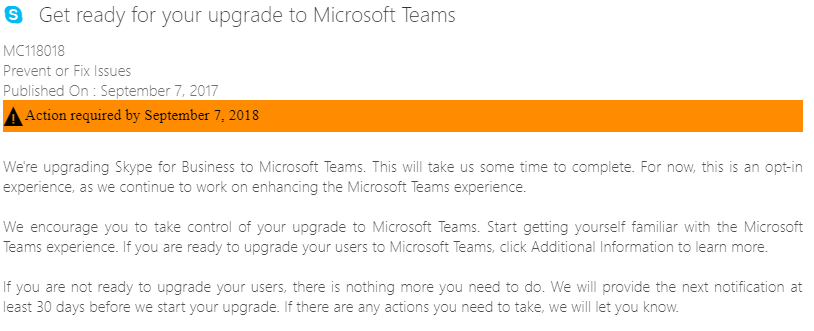It has been speculated that some type of change or re-brand of Skype for Business might be happening due to the overlapping feature set of Teams along with the upcoming Ignite session names. Today’s “glitch” only seemed to add speculation to this. In a blog post by Mary Jo Foley over at zdnet.com, she shows that several people signing into Skype for Business today received a notification that “Skype for Business is now Microsoft Teams!”. However, the message was short lived and was quickly removed. The same happened with this message in the Office 365 Admin Portal Message Center (now also removed):

Without an official announcement from Microsoft (and guessing this won’t happen until Ignite in a couple weeks), we are left with questions as to what this means for current implementations and the future of the on-premises product. Some quick thoughts at this potential news:
- Microsoft Teams is pretty cool. It brings together multiple collaboration elements and adds the persistent chat feature from on-premises Lync and Skype deployments that has been missing.
- Possible new and more streamlined on-premises infrastructure. If you look at the evolution of Exchange from 2007 to 2016, they’ve greatly simplified the server roles and deployment to match what is in the cloud. I hope this means better collocation and easier deployment of server roles for the next version of the on-premises product.
- Another rebranding of the product name. Much of the community grumbled at changing to “Skype for Business” as Lync was gaining its own recognition as well as confusion with the consumer service. Microsoft has also spent significant time in building out the Skype Operations Framework, and partners, like Perficient, have been certified on this content and methodology.
- Teams is still lacking features in comparison to Skype, such as external access, not to mention the more traditional PBX features such as PSTN calling, auto attendants, etc. These features just made it into Skype for Business Online, is there going to be another transition to Teams?
I get it though. The on-premises and Skype Online product code has been around for several years, and being able to add new features or significantly change the code base is probably a hassle. So why not start with something new and build from the ground up? Unfortunately, another significant change like this could turn people away from the service as it is seen as “new” and not fully tested. There are multiple organizations that are now rolling out Skype for Business brand new to their organization, and now potentially need to turn around and make another change.
However, in a few weeks at Ignite we are now expecting an announcement that will clear up this confusion but introduce many more questions. Be on the lookout for future blog posts for more information.
Did you find this article helpful? Leave a comment below or follow me on Twitter (@JeffWBrown) for more information on Skype for Business.

